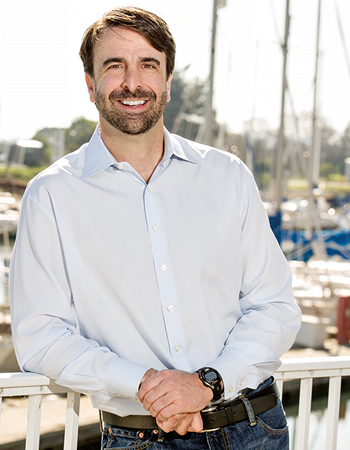The early adopter
Using a unique investment vehicle, Michael Smerklo became a software-as-a-service pioneer with ServiceSource
A
s Michael Smerklo ’97 practices chords during his weekly online guitar lessons, it’s not hard to see the connections to the business revolution he helped launch nearly 18 years ago.
It was 1997, and the Silicon Valley investment banker had raised a small pool of capital in hopes of buying a business. He stumbled upon San Francisco-based ServiceSource, a fledgling operation that was among the first outfits to manage clients’ recurring revenues — ongoing fees that at the time mostly were derived from magazine subscriptions and cable TV bills.
 But the digital age would serve as a potent game changer. An explosion of digital-based subscription services — many of them tied to software and service companies, including Dell, Adobe Systems and Amware Logistics — gave ServiceSource a vital new role in managing recurring revenues.
But the digital age would serve as a potent game changer. An explosion of digital-based subscription services — many of them tied to software and service companies, including Dell, Adobe Systems and Amware Logistics — gave ServiceSource a vital new role in managing recurring revenues.
“Really, as software becomes embedded more and more in everything we do, the opportunity for a recurring revenue stream only goes up,” says Smerklo, who stepped down as CEO from ServiceSource in August, but remains chairman of the board.
ServiceSource went public in 2011 and is the global leader in managing recurring revenue in the business-to-business world — to the tune of $14.5 billion in revenue for some of the world’s most recognizable technology, industrial and media companies. ServiceSource manages recurring revenues “through a combination of highly trained and talented sales professionals and a leading-edge technology platform,” Smerklo says.
The company works beyond simply acquiring new customers, creating 90 percent of revenues from “renewals, cross-sells and upsells.”
“If you think about the magazine subscription invoice coming in the mail and making a decision whether to renew, ServiceSource is 180 degrees from that,” Smerklo says. “It really makes no sense to send an envelope in the mail for services anymore. Most users of technology — certainly in the next generation — wouldn’t even know what to do with it, since they’ll be downloading an app.”
When he stepped down last year, Smerklo had built up a company from 35 employees to more than 3,000 employees in nine locations.
As a pioneer in the field, Smerklo doesn’t need to look past his fretboard to see how he’s benefited from the recurring revenue shift.
“When you think of my guitar lessons, I have never seen a physical bill from them, and I don’t ever expect to,” he says. “I get billed through my credit card with a recurring revenue component. Consuming anything these days is a much different experience, and that’s why I think ServiceSource has even bigger market opportunities ahead of it.”


